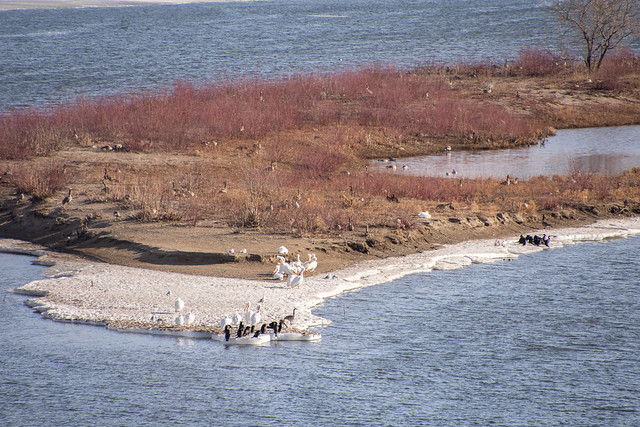 |
| Island bird life, Saskatoon |
We don’t need to go to Cypress Hills or Waskesiu to experience nature. We don’t even need to be in a park. In our towns and cities, nature is all around us – in our backyards, vacant lots, and railway rights of way as well as our riverbanks and parks.
As part of the development of a Green Strategy, the City of Saskatoon held meetings with interested locals on October 29, 2018, to obtain input into draft Natural Areas Standards and an Urban Forestry Management Plan. It was an interesting process and raised a number of questions that merit further discussion and are relevant no matter where you live.
What is a Natural Area?
Saskatoon’s Green Strategy states that the City “will strive to ensure all residents have access to a network of high quality, multifunctional, seamlessly integrated green spaces.” The Strategy then sets out a number of ways in which the City will work to achieve this goal. The majority of the strategies are focused on human interests, but they do include conserving “biodiversity through the identification and conservation of natural areas and by increasing their interconnections.”
Workshop participants pointed out a number of gaps in the current map of Saskatoon’s natural areas. These include (but are not limited to):
- Omission of the river;
- Failure to recognize the important wildlife habitat provided by areas such as cemeteries;
- Omission of wildlife corridors, such as the river valley and railway rights of way;
- Need to incorporate light pollution mitigation strategies and dark sky areas into natural areas standards;
- Fragmentation of natural areas (Saskatoon’s Northeast Swale has been divided into a recreational zone and a core ecological zone) and failure to provide a connection to the river for animals such as deer;
- Inclusion of dog parks, which damage plants and grasses and preclude wildlife habitat; and
- Need to respect the integrity of the ecosystem as a whole by establishing connectivity between natural areas both within and without the city.
- Need for cities to take ownership beyond their formal boundaries (New York City is taking responsibility for maintaining the quality of its watershed);
- Need to provide leadership by offering incentives and regulations for commercial green infrastructure (e.g. green roofs, permeable parking lots);
- Need for a comprehensive strategy: Do we prioritize areas with species at risk? Do we prioritize areas of abundance? Do we protect areas that are no longer wholly natural or do we eliminate them from further consideration because there has been some degradation or they were used for farming in the past? Do we simply maintain and protect or do we attempt to restore?
- Need to recognize that some areas have important ecological value in some seasons or some years but not necessarily all the time (migration staging areas change from year to year, wetlands may only be wet on a seasonal basis);
- Need to identify the requirements of different species. Insects and deer, for example, require different amounts of space and use the land very differently; and
- Need to design parks that help people “understand, appreciate, and stand up for nature, rather than thinking of parks as simply playgrounds.”
 |
| Hyde Park, Saskatoon |
Saskatoon is developing an Urban Forest Management Plan and has identified different categories of trees. Remnant aspen stands and original forested areas are particularly important. It would be interesting to map food forests and analyze their role in ensuring food security. Dead trees play an important role as wildlife habitat and need to be maintained rather than being viewed as messy or potentially dangerous.
Trees have a value far beyond their replacement cost. They provide shade and shelter, wildlife habitat, beauty, and tranquillity. Neighbourhood trees have social and cultural value, forming part of our sense of place and belonging. Discussions around when trees should be maintained, when it’s okay to remove them, and how to compensate for their loss need to consider all these factors. This is particularly difficult when considering trees on private property and requires a designation scheme that takes into consideration heritage value, age and species, etc.
Nature Is All Around Us
Pinpointing natural areas on a map fails to recognize that nature is all around us. Wild animals need a suitable habitat, but that may not be “a remote wilderness or protected sanctuary; it must only have sufficient resources to attract and support a population.” There are 3 times as many endangered species in Australian cities than there are in the country’s rural areas.
Once we accept that we share our cities with other wildlife, we can begin to look at the best ways of cohabiting for mutual benefit. There will need to be educational programs (co-existing with coyotes), infrastructure upgrades (wildlife resistant garbage cans, non-reflective treatments for glass), and clear policies (rules of engagement).
An emerging field is biodiversity-sensitive urban design (BSUD) that contributes to biodiversity, building “nature into the urban fabric by linking urban planning and design to the basic needs and survival of native plants and animals.” BSUD is based on 5 principles: protect and create habitat, help species disperse, minimise anthropogenic threats, promote ecological processes, and encourage positive human-nature interactions. The principles can be applied to individual houses (e.g. green roofs, mix of native trees and plants, reduced building footprint, keeping cats indoors) and extends to neighbourhood design (wide boulevards, courtyard-focused buildings).
